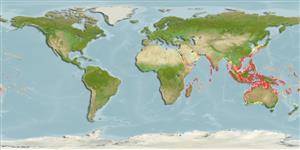Classification / Names
Common names from other countries
Main reference
Size / Weight / Age
Max length : 200 cm WD male/unsexed; (Ref. 3263); common length : 45.0 cm TL male/unsexed; (Ref. 5450); max. published weight: 120.0 kg (Ref. 3263)
Length at first maturity
Lm ?, range 82 - 84 cm
Environment
Marine; brackish; reef-associated; amphidromous (Ref. 51243); depth range 20 - 50 m (Ref. 28016)
Climate / Range
Subtropical; 23°C - 26°C (Ref. 12468), preferred ?; 38°N - 37°S, 34°E - 149°W
Distribution
Indo-Pacific: Persian Gulf (Ref.80050); Red Sea (and eastern Mediterranean via Suez Canal) to southern Africa and French Polynesia, north to Taiwan, south to Australia. Also in the Arafura Sea (Ref. 9819). Collected from the estuary of the River Ganges (Ref. 33178). This name has been used for a number of similar spotted species (Ref. 6871). Probably a species complex (Ref. 35766). Its identity has been confused in many publications and Micronesian specimens should be re-examined (Ref. 37816).
Countries | FAO areas | Ecosystems | Occurrences | Introductions
Short description
Dorsal
spines
(total): 0;
Dorsal
soft rays
(total): 0;
Anal
spines: 0;
Anal
soft rays: 0. Huge stingray with conspicuous dark spots on a light brown disc; spots well-spaced in young but crowded to form reticulated pattern in adult; white ventrally; tail marked with bands of black and white; snout sharply pointed; disc with narrowly rounded outer corners, and tail long, slender and nearly three times body length when intact, with no caudal finfolds; disc without thorns but with band of flat denticles along midback (in adults); usually 1 medium-sized sting on tail (Ref. 5578).
IUCN Red List Status (Ref. 115185)
Human uses
Fisheries: commercial; gamefish: yes
More information
ReferencesAquacultureAquaculture profileStrainsGeneticsAllele frequenciesHeritabilityDiseasesProcessingMass conversion
Tools
Special reports
Download XML
Internet sources
Estimates of some properties based on models
Phylogenetic diversity index
PD50 = 0.5000 many relatives (e.g. carps) 0.5 - 2.0 few relatives (e.g. lungfishes)
Trophic Level
3.6 ±0.6 se; Based on diet studies.
Resilience
Very Low, minimum population doubling time more than 14 years (Fec=3-5)
Vulnerability
Very high vulnerability (90 of 100)
Price category
